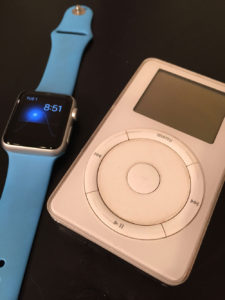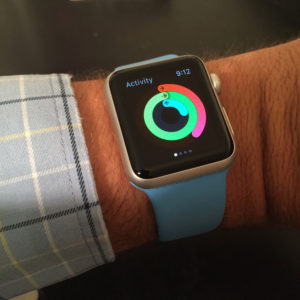
I bought an Apple Watch. It’s pretty cool.
I’m not one for buying expensive new gadgets. Like most geeks, I buy my share of technology, but my upgrade cycles tend to be long, and if I do get something bright and shiny, it’s because it satisfies a specific need. My original iPod, for example, let me stop renting audio books from BooksOnTape.com, replacing a $45 monthly fee and snail mailed boxes of audio tapes with one small device and an $15 Audible subscription.
The Apple Watch wasn’t like that. While I’d been considering some sort of simple smartwatch (a Pebble) or a lightweight biometrics device (a Fitbit) ever since stepping up my exercise routine, going full blown smart watch wasn’t on my radar. It was mostly a question of cost — an Apple Watch is $350, $400 if you throw in AppleCare. It simply wasn’t in my budget … until I won an award from the non-profit Moodle group I belong to. That award included $500 … and suddenly a smartwatch became a possibility.
I spent some time looking at possibilities, namely the various Galaxy Gear watches, Fitbits and Apple Watch. I bought Apple Watch because it offered a variety of applications, tight integration with my iPhone 6, and — with the release of watchOS 2 update — remedies for the watch’s most glaring drawbacks.
The key thing to understand about the Apple Watch (as of August 29, 2015) is that it is highly dependent on the iPhone for internet access, GPS, and much of its application processing. It communicates with the iPhone 6 via Bluetooth, and if you take the phone away, a lot of the watch’s capabilities go with it because it has no built-in cellular connection of its own.
This isn’t surprising — the Galaxy Gear S has a built in cellular modem, and the thing is huge. I didn’t want huge, and given that I almost always have my phone with me, the fact that much of the heavy lifting wasn’t being done by the watch isn’t a problem for me. That said … it could (and will be) better.
The main drawback of the phone dependency is lag because the watch has to talk to the phone for so many of its tasks. This is particularly obvious with apps that query the internet, like Dark Sky, where you’ve got two hops (watch -> phone -> Internet) rather than just connecting to the Internet directly. watchOS 2 remedies this by allowing the watch to connect to wi-fi networks independently of the phone. That means that leaving my phone in my work office won’t turn my watch into just another time piece.
The other problem the phone-focused app processing is that watchOS apps is that it causes the phone apps to feel sluggish. It’s not cripplingly slow, but it does leave you wishing it was faster. watchOS 2 addresses this by allowing app developers to move more of their processing to the watch.
Run, Geek, Run

In buying the watch, I expected I’d use the biometrics piece the most, and I have. The watch comes with the Activity app, which tracks calories burned (actively and passively), exercise, and how much you stand in a day. When I go for a walk or run, I can start an exercise activity and the watch records my heart rate, distance traveled, pace, and calories burned.
All this data gets reported back to the Activity and Health apps on my phone. In some ways this doesn’t tell me anything I don’t already know — e.g. I exercised more in July than I did in August — but where it helps most is busting your personal myths. It’s easy to forget just how much less I exercised this month than last, and tell myself it’s not really that bad. But in truth … it was.
There are some drawbacks to the app. Activity won’t let me set my own custom activity types (e.g. swimming or disc golf) and instead just gives me a generic option for “Other” that counts as “brisk walk”. The Apple Watch is water resistant, not water proof, so I won’t be taking it swimming but I’d like to be able to log that activity all the same.
The Activity app records the distance I traveled but not the path I took. You need to use something like Runkeeper for that. That’s disappointing, and frankly, it seems like the sort of no-brainer data collection that should be built-in to the Apple app. The data reporting options are also limited — I can not, for example, easily do month-over-month comparisons of calories burned or minutes exercising, nor can I get a summary report of the sorts of activities I did in a given month.
None of this is a deal breaker, and frankly the Activity app gives me about as much information as I personally need, but if you’re a diehard data person you’ll want to look to third-party watch apps for advanced data collection and reporting.
The watch has positively impacted my workouts. It tracks my weekly totals, and adjusts my goals based on how well I’m doing. On more than one occasion those goals have caused me to go for another walk or run rather than sit on my butt and play video games. At work, the hourly reminders to stand and move are very helpful; as an Information Technology guy that’s something I struggle with.
The the lack of GPS tracking in Activity isn’t a big deal for me — I know where I run, and the route doesn’t change that much from morning to morning. As such, I’m looking to experiment with leaving my phone at home. You can load a playlist with up to 2 GB of songs onto the watch and it can connect to wireless earbuds via Bluetooth. In theory this would allow me run without my phone, which in turn would insure that it doesn’t get shattered if/when it comes flying out of my hand and/or pocket.
I don’t have Bluetooth earbuds yet, but they are next on my research list. I’d gladly sacrifice a little data for a more comfortable morning run, but there is a big drawback: the watch doesn’t do [Audible[(http://www.audible.com/) audio books.
While my phone and iTunes can handle Audible’s DRM, the watch itself can only handle DRM-free files. I’m hoping that watchOS 2’s new support for better native phone apps will lead to an Audible app that can play files without the phone.
Another potential drawback for heavy exercisers is how much power the Activity app draws from the watch. An hour run in the morning typically drains 15% of the watch’s battery. The remaining 85% is more than enough for me to get through my day, even with an evening walk thrown in, but distance runners and others who exercise for hours at a clip may find themselves needing to recharge the watch after their work out.
In 60 minutes, remind me about that thing I’m about to forget
I knew I’d use the watch for biometrics, but I had no idea how much I’d use it for reminders. In theory, this is nothing new — I can easily use Siri on my iPhone to set reminders for myself. In practice though, I never did it because it wasn’t practical to keep digging out my phone everything I wanted to note something.
The watch is omnipresent though, and I use it all the time to remind myself to do the dishes, load the washing machine and dryer, pick up the kids, do some random task that someone asked about but I didn’t have time to right down, etc.
This is huge for me — I’m notoriously bad at remembering things if I don’t write it down. Having quick access to notes on my watch makes setting reminders so much easier. The same goes for alarms; I can easily tell my watch to set an alarm for a certain time. When it goes off, the watch’s haptic engine gives me a gentle tap on my wrist.
My only complaint is that Apple didn’t include a Reminders app on the watch, so I can’t see the reminders I’ve set for myself without checking my phone. This is dumb; it’s the sort of quick hit, glanceable information that should be on the watch, and the lack of such an app is an annoying oversight.
Dick Tracy should have been texting
Something else that surprised me was how much I use the watch for texting. If I’m not using my phone or Messages on my Mac, then texts are displayed on my watch. I can then respond to them using canned messages (“yes”, “no”, “I’ll call you later”, and others) or I can record a response. That response can be sent as an audio file or transcribed to be sent as text. While this has the potential to be incredibly distracting if you get a lot of texts, for me it’s not. Most of the texts I receive are from my family, and they are ones that I typically need to respond to quickly. My responses often tend to be simple, and the default responses cover 80% of what I need to say.
The watch also allows me to take calls on it. I’ve only used it a few times, but I have to say … it’s awkward. Sure, it looked all kinds of cool when Dick Tracy did it but it feels weird to talk to your wrist for extended periods of time (and it’s surprisingly hard on your arm as well). It’s fine for quick hit conversations when you don’t want to dig out your phone, but it’s nothing I’d want to use for more than a few minutes.
Fun, but not essential
There are a few other things I use my watch for. I do use it to check the time quite frequently, and I like the assortment of watch faces that are included (though I could use more). I typically use the “Solar” watch face, which displays where the sun is in the sky, as well as the date and time. It’s my distraction-free watch face and the one I use when I don’t need quick access to a lot of other information.
I also like “Color”, which lets you set the color of the watch face and configure up to four “complications” that are quick links to watch apps like the Timer and Activity. It’s useful when I’m juggling a lot of things at once, but in general I try to avoid information overload on my watch.
I use Dark Sky a lot to check on the weather, but that’s probably the app that suffers the most from relying on the phone for its data; I’m hoping it will be more responsive when watchOS 2 drops.
All in all, I’m having a lot of fun with the watch, and I’m enjoying experimenting with different ways to use it, but it’s not an essential edition to my personal technology line-up. I could have survived without it … but I’m glad I don’t have to.

